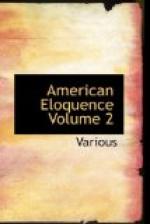Immigration into Kansas was organized at once by leading men of the two sections, with the common design of securing a majority of the voters of the territory and applying “popular sovereignty” for or against slavery. The first sudden inroad of Missouri intruders was successful in securing a pro-slavery legislature and laws; but within two years the stream of free-State immigration had become so powerful,in spite of murder, outrage, and open civil war, that it was very evident that Kansas was to be a free-State. Its expiring territorial legislature endeavored to outwit its constituents by applying for admission as a slave State, under the Lecompton constitution; but the Douglas Democrats could not support the attempt, and it was defeated. Kansas, however, remained a territory until 1861.
The cruelties of this Kansas episode could not but be reflected in the feelings of the two sections and in Congress. In the former it showed too plainly that the divergence of the two sections, indicated in Calhoun’s speech of 1850, had widened to an absolute separation in thought, feeling, and purpose. In the latter the debates assumed a virulence which is illustrated by the speeches on the Sumner assault. The current of events had at least carried the sections far enough apart to give striking distance; and the excuse for action was supplied by the Dred Scott decision in 1857.
Dred Scott, a Missouri slave, claiming to be a free man under the Missouri compromise of 1820, had sued his master, and the case had reached the Supreme Court. A majority of the justices agreed in dismissing the suit; but, as nearly every justice filed an opinion, and as nearly every opinion disagreed with the other opinions on one or more points, it is not easy to see what else is covered by the decision. Nevertheless, the opinion of the Chief justice, Roger B. Taney, attracted general attention by the strength of its argument and the character of its views. It asserted, in brief, that no slave could become a citizen of the United States, even by enfranchisement or State law; that the prohibition of slavery by the Missouri compromise of 1820 was unconstitutional and void; that the Constitution recognized property in slaves, and was framed for the protection of property; that Congress had no rights or duties in the territories but such as were granted or imposed by the Constitution; and that, therefore, Congress was bound not merely not to forbid slavery, but to actively protect slavery in the Territories. This was just the ground which had always been held by Calhoun, though the South had not supported him in it. Now the South, rejecting Douglas and his “popular sovereignty,” was united in its devotion to the decision of the Supreme Court, and called upon the North to yield unhesitating obedience to that body which Webster in 1830 had styled the ultimate arbiter of constitutional questions. This, it was evident, could never be. No respectable authority at the North pretended




